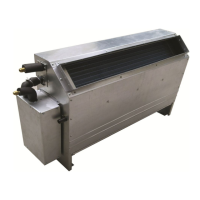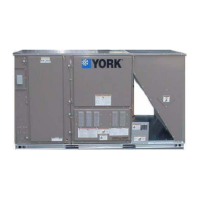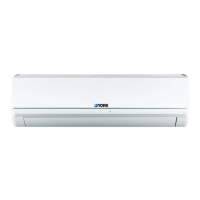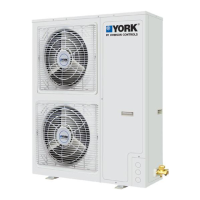52
JOHNSON CONTROLS
FORM 145.05-NOM1 (708)
Sequence of Operation
Supply Air Temperature Control
The mechanical cooling will be enabled when the supply
air temperature is 5.0° F greater than the “AC / ECON
S/A SP” set point. Mechanical cooling will be disabled
when the supply air temperature is 10.0° F less than
the “AC / ECON S/A SP” set point. The control waits
five minutes from the time the supply air temperature
drops 10.0° F below the set point before it disables the
mechanical cooling.
The control compares the supply air temperature to
the “AC / ECON S/A SP” set point and generates a
variable percentage output based on the difference and
the amount of change in the supply air temperature to
a change in output.
Return Air Temperature Control
When the unit is under Return Air Temperature Control,
the mechanical cooling will be enabled when the return
air temperature is 2.0° F greater than the “AC / ECON
R/A SP” set point. Mechanical cooling will be disabled
when the return air temperature is 0.5° F less than the
“AC / ECON R/A SP” set point. The control waits
five minutes from the time the return air temperature
drops 0.5° F below the set point before it disables the
mechanical cooling.
The control compares the return air temperature to the
“AC / ECON R/A SP” set point plus 1.0° F and generates
a variable percentage output based on the difference and
the amount of change in the return air temperature to a
change in output.
Dew Point Temperature Control (FlexSys Units)
In addition to Supply Air Temperature Control and
Return Air Temperature Control, Dew Point Temperature
Control can also be selected on FlexSys units. The Unit
Control compares the derived Dew Point Control set
point and the dew point of the supply air; and generates
an analog output based on the difference and the amount
of response to a given change in output.
Coil Leaving Temperature Control (FlexSys Units)
On FlexSys units the control will compare the supply
air leaving the evaporator coil and compare it to 40.0°
F; and generate an analog output based on the difference
and the amount of response to a given change in output.
This is a reverse acting loop. As the temperature drops
below 40.0° F, the by-pass damper output increases.
Compressor Analog Output
If both Supply Air and Return Air Temperature Control
is selected, the Unit Control will use the lower of the
two outputs to control the compressors.
On FlexSys units the Unit Control will subtract the Coil
Leaving Temperature Control analog output from the
above; and use this value to control the compressors.
On FlexSys units if Supply Air Temperature Control
and Dew Point Control are selected, it will pick the
higher of the two outputs and then subtract the Coil
Leaving Temperature Control analog output; and use the
resulting analog value to control the compressors.
On FlexSys units if Return Air Temperature Control
and Dew Point Control are selected, it will pick the
higher of the two outputs and then subtract the Coil
Leaving Temperature Control analog output; and use the
resulting analog value to control the compressors.
On FlexSys units if Supply Air Temperature Control,
Return Air Temperature Control, and Dew Pont Control
are selected; the Unit Control will compare the Supply
Air Temperature Control output to the Return Air
Temperature Control output and select the lower of the
two outputs. It will then compare it to the Dew Point
Control output and select the higher of the two values;
and then subtract the Coil Leaving Temperature Control
analog output and use the resulting analog value to
control the compressors.
TABLE 14 – WINDOW OF OPERATION, COMPRESSOR STAGING
2-COMP / 2-STAGES 2-COMP / 3-STAGES 4-COMP / 4-STAGES 4-COMP / 6- STAGES
TURN OFF TURN ON TURN OFF TURN ON TURN OFF TURN ON TURN OFF TURN ON
STAGE 1 35% 50% 18.5% 33.5% 10% 25% 1.5% 16.5%
STAGE 2 85% 100% 51.5% 66.5% 35% 50% 18% 33%
STAGE 3 - - 85% 100% 60% 75% 35% 50%
STAGE 4 - - - - 85% 100% 51.5% 66.5%
STAGE 5 - - - - - - 73% 88%
STAGE 6 - - - - - - 85% 100%
Sequence of Operation

